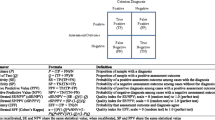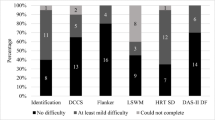Abstract
This study was conducted to evaluate the convergent and discriminant validity of vigilance measures of attention and impulsivity in children. One hundred children referred for evaluation of attention and learning problems were administered a battery of tests including two vigilance tasks, other laboratory measures of inattention and impulsivity, and parent and teacher ratings. It was predicted that vigilance task performance would correlate with teacher ratings and laboratory measures of inattention while correlations with ratings of aggressive behavior were predicted to be lower. Moderate correlations were obtained between the vigilance task scores and other laboratory measures of inattention and impulsivity. However, the vigilance scores did not correlate with teacher or parent ratings of behavior. A factor analysis, conducted to identify underlying dimensions of attention in the battery of tests, revealed strong source effects. The implications for use of vigilance measures in diagnosis are discussed.
Similar content being viewed by others
References
Achenbach, T. M., & Edelbrock, C. (1983).Manual for the Child Behavior Checklist and Revised Child Behavior Profile. Burlington: University of Vermont, Department of Psychiatry.
Aman, M. G., & Turbott, S. H. (1986). Incidental learning, distraction, and sustained attention in hyperactive and control subjects.Journal of Abnormal Child Psychology, 14, 441–455.
American Psychiatric Association (1987).Diagnostic and statistical manual of mental disorders (3rd ed., rev.). Washington, DC: Author.
Buchsbaum, M. S., Haier, R. J., Sostek, A. J., Weingartner, H., Zahn, T. P., Siever, L. J., Murphy, D. L., & Brody, L. (1985). Attention dysfunction and psychopathology in college men.Archives of General Psychiatry, 42, 354–360.
Campbell, S. B., Douglas, V. I., & Morgenstern, G. (1971). Cognitive styles in hyperactive children and the effect of methylphenidate.Journal of Child Psychology and Psychiatry, 12, 55–67.
Charles, L., Schain, R. J., Zelniker, T., & Guthrie, D. (1979). Effects of methylphenidate on hyperactive children's ability to sustain attention.Pediatrics, 64, 412–418.
Dainer, K. B., Klorman, R., Salzman, L. F., Hess, D. W., Davidson, P. W., & Michael, R. L. (1981). Learning-disordered children's evoked potentials during sustained attention.Journal of Abnormal Child Psychology, 9, 79–84.
Draeger, S., Prior, M., & Sanson, A. (1986). Visual and auditory attention performance in hyperactive children: Competence or compliance.Journal of Abnormal Child Psychology, 14, 411–423.
Eliason, M. J., & Richman, L. C. (1987). The continuous performance test in learning disabled and nondisabled children.Journal of Learning Disabilities, 20, 614–619.
Goyette, C. H., Conner, C. K., & Ulrich, R. F. (1978). Normative data on revised Conners Parent and Teacher Rating Scales.Journal of Abnomal Child Psychology, 6, 221–236.
Halperin, J. M., Wolf, L. E., Pasculuaca, D. M., Newcorn, J. H., Healey, J. M., O'Brien, J. D., Morganstein, A., & Young, J. G. (1988). Differential assessment of attention and impulsivity in children.Journal of the American Academy of Child and Adolescent Psychiatry, 27, 326–329.
Hinshaw, S. P. (1987). On the distinction between attentional deficits/hyperactivity and conduct problems/aggression in child psychopathology.Psychological Bulletin, 101, 443–463.
Kagan, J., Rosman, B. L., Day, D., Albert, J., & Phillips, W. (1964). Information processing in the child: Significance of analytic and reflective attitudes.Psychological Monographs: General and Applied, 78 (1, Whole No. 578).
Kaufman, A. S. (1975). Factor analysis of the WISC-R at 11 age levels between 6 1/2 and 16 1/2.Journal of Consulting and Clinical Psychology, 43, 135–147.
Keogh, B. K., & Margolis, J. S. (1976). A component analysis of attentional problems of educationally handicapped boys.Journal of Abnormal Child Psychology, 4, 349–359.
Klee, S. H., & Garfinkel, B. D. (1983). The computerized performance task: A new measure of attention.Journal of Abnormal Child Psychology, 11, 487–496.
Koriath, U., Gualtieri, T., VanBourgondien, M. E., Quade, D., & Werry, J. S. (1985). Construct validity of clinical diagnosis in pediatrie psychiatry: Relationships among measures.Journal of the American Academy of Child Psychiatry 24, 429–436.
Kupietz, S. S., & Richardson, E. (1978). Children's vigilance performance and inattentiveness in the classroom.Journal of Child Psychology and Psychiatry, 19, 145–153.
Langhorne, J. E., Loney, J., Paternite, C. E., & Bechtoldt, H. P. (1976). Childhood hyperkinesis: A return to the source.Journal of Abnormal Psychology, 85, 201–209.
Lindgren, S. D., & Lyons, D. A. (1984).Pediatric Assessment of Cognitive Efficiency (PACE). Iowa City: University of Iowa, Department of Pediatrics.
Loney, J., & Milich, R. (1982). Hyperactivity, inattention, and aggression in clinical practice. In M. Wolraich & D. K. Routh (Eds.),Advances in developmental and behavioral pediatrics (Vol. 3, pp. 113–147). Greenwich, CN: JAI Press.
Margolis, J. S. (1972).Academic correlates of sustained attention. Unpublished doctoral dissertation. University of California at Los Angeles.
Milich, R., & Landau, S. (1988). Teacher ratings of inattention/overactivity and aggression: Cross validation with classroom observations.Journal of Clinical Child Psychology, 17, 92–97.
Milich, R., Loney, J., & Landau, S. (1982). Independent dimensions of hyperactivity and aggression: A validation with playroom observational data.Journal of Abnormal Psychology, 91, 183–198.
Nuechterlein, K. H. (1983). Signal detection in vigilance tasks and behavioral attributes among offspring of schizophrenic mothers and among hyperactive children.Journal of Abnormal Psychology, 92, 4–28.
O'Dougherty, M., Nuechterlein, K. H., & Drew, B. (1984). Hyperactive and hypoxic children: Signal detection, sustained attention, and behavior.Journal of Abnormal Psychology, 93, 178–191.
Ownby, R. L., & Matthews, C. G. (1985). On the meaning of the WISC-R third factor: Relations to selected neuropsychological measures.Journal of Consulting and Clinical Psychology, 53, 531–534.
Pelham, W. E., Milich, R., Murphy, D. A., & Murphy, H. A. (1989). Normative data on the IOWA Conners Teacher Rating Scale.Journal of Clinical Child Psychology, 18, 259–262.
Ross, D. M., & Ross, S. A. (1982).Hyperactivity: Current issues, research and theory (2nd ed.). New York: Wiley.
Rutschmann, J., Cornblatt, B., & Erlenmeyer-Kimling, L. (1977). Sustained attention in children at risk for schizophrenia: Report on a continuous performance test.Archives of General Psychiatry, 34, 571–575.
Sattler, J. M. (1988).Assessment of children. San Diego: Author.
Shapiro, S. K., & Garfinkel, B. D. (1986). The occurrence of behavior disorders in children: The interdependence of attention deficit disorder and conduct disorder.Journal of the American Academy of Child Psychiatry, 25, 809–819.
Sostek, A. J., Buchsbaum, M. S., & Rapoport, J. L. (1980). Effects of amphetamine on vigilance performance in normal and hyperactive children.Journal of Abnormal Child Psychology, 8, 491–500.
Sykes, D. H., Douglas, V. I., & Morgenstern, G. (1973). Sustained attention in hyperactive children.Journal of Child Psychology and Psychiatry, 14, 213–220.
Tarnowski, K. J., Prinz, R. J., & Nay, S. M. (1986). Comparative analysis of attentional deficits in hyperactive and learning-disabled children.Journal of Abnormal Psychology, 95, 341–345.
Ullmann, R. K., Sleator, E. K., & Sprague, R. L. (1985). A change of mind: The Conners Abbreviated Rating Scales reconsidered.Journal of Abnormal Child Psychology, 13, 553–565.
Author information
Authors and Affiliations
Rights and permissions
About this article
Cite this article
Lovejoy, M.C., Rasmussen, N.H. The validity of vigilance tasks in differential diagnosis of children referred for attention and learning problems. J Abnorm Child Psychol 18, 671–681 (1990). https://doi.org/10.1007/BF01342753
Revised:
Issue Date:
DOI: https://doi.org/10.1007/BF01342753




